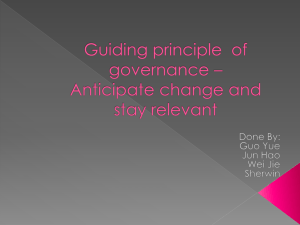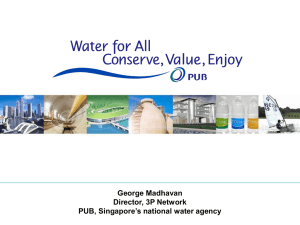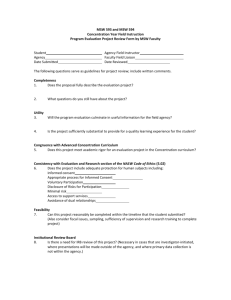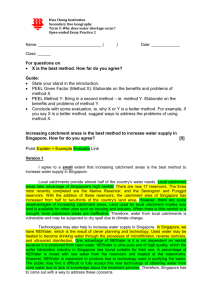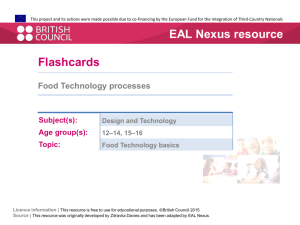historical evolution of waste management
advertisement
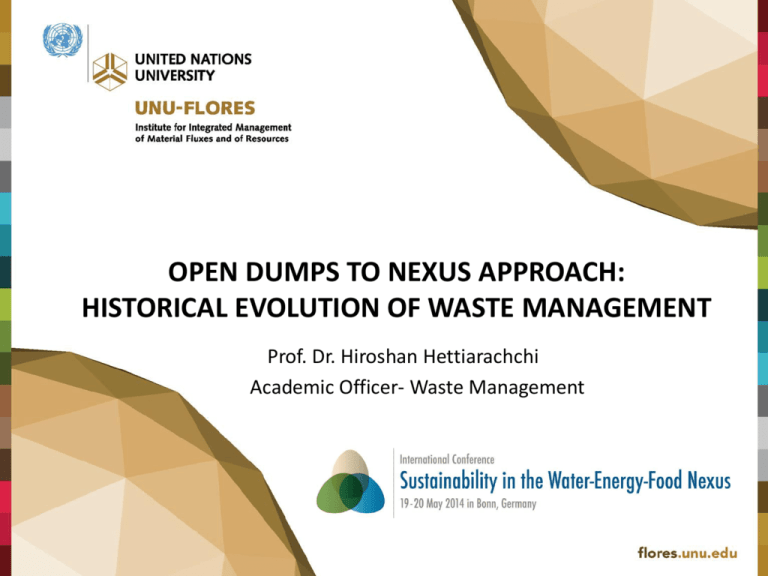
OPEN DUMPS TO NEXUS APPROACH: HISTORICAL EVOLUTION OF WASTE MANAGEMENT Prof. Dr. Hiroshan Hettiarachchi Academic Officer- Waste Management Waste: Why is it an issue Total annual MSW generation in the U.S. has increased by more than 60% since 1980 to the current level of 251 million tons per year (USEPA 2007). – In 2005, 54% of MSW generated in the U.S. was disposed of in 1,654 landfills1. – Hundreds more existing traditional dry landfills are expected to reach their authorized capacity (Sharma and Reddy, 2004). 1 MSW Factsheet, Center for sustainable Systems, University of Michigan, 2008 2 Global scale http://www.letsdoitworld.org/ Who is to bla e…? One of the attempts to show the total amount of waste generated in all countries. Modified sizes of countries show the aggregate quantity of waste produced, and the colours are used to identify specific countries based on the min-imap in the bottom left corner. Source: Worldmapper, 2011 (www.letsdoitworld.org). Waste: Is it really waste? Conclusion: Waste is a resource and should be treated as such Byproduct of the process of consumption, Resource that can be processed to obtain useful things Value not visible until material is separated which is usually expensive (www.hardrainproject.com/hrpl?n=7989) However, in some developing societies it is the livelihood of people 5 Timeline: Early Days to Medieval Age Ancient trash dumps, or middens, such as this one at Harappa (2600–1900 BC) in Pakistan, are rich hunting grounds for archaeologists (cnn.com) Pichtel (2005) Timeline: Industrial Age & the 20th Century Manlove, Alliott & Co. Ltd. 1894 destructor furnace at Cambridge Museum of Technology (wikipedia.org) Timeline: Turning Point 97 ’s a d up Sustainable management became a popular term. This means: Minimizing volume generated and flown and Utilization of waste to produce useful products RRR (reduce, reuse, recycle) also became popular concept over the past 30-40 years. 9 What is ISWM? This also lead to the integration of different aspects in waste a age e t resulti g i a popular phrase I tegrated “olid Waste Ma age e t I“WM . epa.gov/globalwarming Issues with the current management tools • Did ISWM help? – Yes. But it does not solve all issues • Some components are still not integrated – Waste water management is an example • Some aspects are very complex and global – Illegal dumping, transportation and disposal of e-waste are examples Issues: Severity varies with geography Developed world: Under control in some ways. Minimum impact. Rural developing world: Less severe impact, less populous, low consumption rates, high organic content Urban developing world: Most severely affected places, densely populated, economically less prosperous, and have less access to new technologies Examples: Mega cities such as Calcutta, Jakarta, and Sao Paulo Latin America: More than 80% (> 600million people) lives in urban areas . 12 Bangkok (left) and Quito (right) – (Source: Prof. Patrick Hettiaratchi) Issues: Technology Transfer No one solution fits all situations: Successful solution from one country should not be forced upon another Nature of the issues can look alike But issues may be tied to the society/economy in different ways Example: scavengers in the waste dump Replacing dumps with sanitary landfills can make adverse impacts, if interrelations have not been identified and addressed Potential Solution: Professional establishment for people to do picking or scavenging in a safe and healthy environment, before waste reaches the final destination (a landfill) 13 What is next? Why not look at all related material resources in one picture before, making decisions on management tools? Take all interrelated material resources and analyze/plan as one nexus; so we call it “nexus approach” In terms of food security water, soil and waste are interconnected. Water and soil are natural resources; value well understood Waste is a man-made resource; not seen as a resource by many Thinking Outside the box: NEWater as an Example • NEWater is the brand name given to ultra-pure water that is produced from reclaimed water in Singapore. • Wastewater, which is called used water in Singapore, is treated in conventional advanced wastewater treatment plants that are called reclamation plants in Singapore. • The effluent from the reclamation plants is either discharged into the sea or it is further treated in NEWater plants using dual-membrane (via microfiltration and reverse osmosis) and ultraviolet technologies. • The quality of NEWater is monitored by, among others, an international panel of experts. The quality of NEWater exceeds WHO standards for drinking water. www.wikipedia.com Thinking Outside the box: OrbSys Shower as an Example • Young scientist (Mahdjoubi’s) from Sweden • For a 10-minte shower, the closed-loop system utilizes an advanced real-time water filtration system • continuously heat, sanitize and pump a set amount of water measuring as little as 1.5 gallons • flows from the shower head, down to the drain and then re-circulates back again • cuts water usage on average by 90 percent and energy by 80 percent compared to standard showers. • In economic terms, having a unit installed can translate to a combined water and energy savings of at least €1,000 ($1,351) annually for each person. http://www.cnn.com/2013/11/11 /tech/innovation/futuristic-waterrecycling-shower-orbsys/ www.smithsonianmag.com CONCLUDING REMARKS Waste can easily become a nuisance if not managed properly. Waste is a resource. But many are still not used to seeing the value in waster in terms of material resources. The management aspects of waste have evolved; but not at the rate we want it to evolve. Taking a nexus approach to handle waste together with soil, and water, makes sense in terms of the material flow and interrelations. More research needed to understand the complex interrelations 17 UNU-FLORES More info: http://flores.unu.edu

